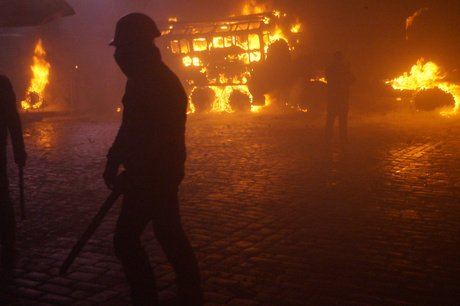Less
than two months ago, the average protester looked a bit different: he
or she likely hailed from western or central Ukraine, with less
radical demands and would even have been satisfied with the
resignation of the government. Victory then could have come without
the resignation of the president.
Both
portraits were given by Ukrainian
sociologist and political analyst Iryna Bekeshkina during a
presentation of new research conducted by Democratic Initiatives on
the evolution of the EuroMaidan movement. The research was done in
three phases on Dec. 7 and 8 (Maidan-demonstration), Dec. 20 (Maidan-camp) and Feb. 3 (Maidan-sich). The latter focused on
502 protesters who have consistently stayed at the EuroMaidan tent
camp on Independence Square. The studies on Dec. 7,8 and 20 surveyed
1,037 and 515 protesters, respectively.
- Obtain the most current Ukraine news articles released today.
- Get the newest Ukraine news reports as of today.
JOIN US ON TELEGRAM
Follow our coverage of the war on the @Kyivpost_official.
Oleksandr
Yamchanka is a EuroMaidan
activists and a near spitting image of the study’s typical
protester. Lviv born, he is 33 years old, a doctor and a scientist.
He says he is not going to leave the protests any time soon. In the
beginning, it was enough for him that the government and Yanukovych
resign. But now, he says, he and those on Maidan “want to change
the whole existing system.”
As
EuroMaidan enters its third month, the movement
has changed significantly, the study says, beginning with EuroMaidan
geography, the background of protesters and their age and ending with
protesters’ demands and methods of resistance.

According
to the data collected on Feb. 3, 88 percent of EuroMaidan protesters
are men, 56 percent of them are 30 to 54 years old, 43 percent of
them have higher education and another 43 percent have secondary
education or college training.
There
are 27 percent of specialists with higher education and 17 percent of
private entrepreneurs at EuroMaidan. Both of those numbers have
significantly increased since the last study round on Dec. 20, from
22 and 12 percent, respectively.
The
majority of protesters are out-of-towners. More people have come from
western Ukraine: 55 percent compared to 42 during the previous
research round, with 24 percent from central Ukraine and 21 percent
from the east.
According
to the research,
though, the resignation of Yanukovych has become one of two main
EuroMaidan demands, with 85 percent of people calling it one of the
most significant conditions. The other is the release of arrested
protesters, which 85 percent of those surveyed also want.
The
study also shows that 82
percent have decided to stay at EuroMaidan until all the demands are
fulfilled – a significant increase since the second round of the
research on Feb. 3, which found that 63 percent would stay until the
end, and since the first round, when 73 percent said they would stay.
“Nothing
on Earth would make me leave before Yanukovych resigns,” says
33-year-old EuroMaidan protester Kateryna, supporting the research
data. The woman says she is an active participant of the
“Mothers of Maidan” movement and a mother of a 17-year-old
daughter. She refused to give her last name because she feared
repercussions at work.
“I
am asking you not to mention my last name, I know the information
about protesters is being
tracked,” she explains.
Democratic
Initiatives’ analyst Oleksiy Hmelko says that the group’s
experience in round
three of the study shows that people have become much more suspicious
since Dec. 20.
“Many
feared that
the interviewer could be a provocateur, even though our people had
all possible identification papers,” he said.
Bekeshkina
says earlier research rounds showed the opposite situation.
“People
were very
willing to talk, while now… its inhabitants are waiting for an
attack,” she explained.
According
to the sociologist there are three distinctive features of the
current EuroMaidan: it has no vertical power structure; it answers to
no politician and has its own demands; and it is radical.

Protesters
do not deny
this.
“This
radicalization of Maidan is a response to no feedback to Maidan’s
peaceful demands, a natural response I would say,” says Yamchanka,
the doctor. “These radicals are people who were peacefully
protesting for two months. If you were knocking on the door for two
months without any response, wouldn’t you finally kick it to open?”
The
study’s results support the radicalization. More than 41 percent of
protesters are ready to take part in the seizure of administrative
buildings now, compared to 13 and 19 percent during the two previous
rounds. At the same time, more than 50 percent are ready to take part
in the creation of independent military units, compared to 15 and 21
percent during the past studies, respectively.
And
Yamchanka says EuroMaidan will continue evolving, “especially if
authorities continue trying to add fuel to the fire,” he said.
Sociologist
Bekeshkina agreed.
“Maidan is not just people or events, Maidan is a living phenomenon
and everyone should understand that,” she said.
Kyiv
Post staff writer Daryna Shevchenko can be reached at
shevchenko@kyivpost.com.
You can also highlight the text and press Ctrl + Enter




